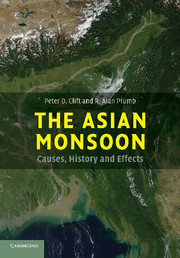Book contents
- Frontmatter
- Contents
- Preface
- Acknowledgements
- 1 The meteorology of monsoons
- 2 Controls on the Asian monsoon over tectonic timescales
- 3 Monsoon evolution on tectonic timescales
- 4 Monsoon evolution on orbital timescales
- 5 Erosional impact of the Asian monsoon
- 6 The Late Holocene monsoon and human society
- References
- Further reading
- Index
- Plate section
3 - Monsoon evolution on tectonic timescales
Published online by Cambridge University Press: 01 September 2009
- Frontmatter
- Contents
- Preface
- Acknowledgements
- 1 The meteorology of monsoons
- 2 Controls on the Asian monsoon over tectonic timescales
- 3 Monsoon evolution on tectonic timescales
- 4 Monsoon evolution on orbital timescales
- 5 Erosional impact of the Asian monsoon
- 6 The Late Holocene monsoon and human society
- References
- Further reading
- Index
- Plate section
Summary
Proxies for monsoon intensity
If models that propose coupling between solid Earth tectonic processes and monsoon strength are to be tested then we must first produce reconstructions of monsoon evolution over long, tectonic timescales that can be compared with histories of mountain building or ocean closure. In this chapter we review the existing evidence for such development, typically over spans longer than one million years. We examine evidence from both oceanic and continental sources to see how the oceanography and climatic evolution are linked and then comment on how these relate to the tectonic evolution of Asia discussed in Chapter 2. Finding proxies for “monsoon intensity” in the seas that surround Asia is a complicated task because the nature of the monsoon changes from the Arabian to the South China Seas, as well as going from south to north Asia. Furthermore, the winter monsoon is often manifest in a different fashion than the summer monsoon, requiring separate proxies to be developed for each part of the system. For example, while the monsoon in the Arabian Sea is strongest in the summer and is characterized by powerful winds and oceanic upwelling, the monsoon in Bangladesh is largely characterized by heavy summer rains. Conversely, in northern China, while the monsoon does involve summer rains, it is dominated in that area by winter winds and dust storms. Thus the prospect of a “silver bullet” monsoon proxy that can be applied to areas at all periods of geological time is not likely.
- Type
- Chapter
- Information
- The Asian MonsoonCauses, History and Effects, pp. 49 - 94Publisher: Cambridge University PressPrint publication year: 2008



